Go cross-country skiing and wear your breath.

Friday’s snowfall – mini-blizzard, at best – laid down an excellent layer of snow, and by gum Northfield’s intrepid skiers had created some excellent trails by the afternoon. I enjoyed a good hour-long ski (actually, 40 minutes of skiing and 20 minutes of happy conversation with other skiers and a bowhunter [!]) in the near-perfect conditions. Heaven at 22°F, and more of the same tomorrow.
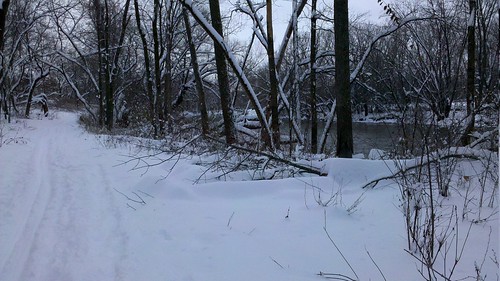
You probably didn’t notice, but Saturday saw the start in Sweden of the cross-country skiing World Cup – the sport’s highest level of competition, and (I’m not ashamed to say) something of an obsession of mine.
Don’t get me wrong: I know nordic skiing is well beyond obscure in the context of international sport. Honestly, the obscurity is something of an attraction – but not as much an attraction as the serious competition among and achievement of the racers, who contest dozens of grueling races throughout Europe (and occasionally in North America) from November to March – including, this year, a world championship in the city that arguably invented modern cross-country skiing: Oslo. XC skiers are among the world’s fittest athletes, at least on some measures, and as a skier, I can feel some small amount of kinship with them as I, too, try to climb a steep hill.
Beyond that personal, emulative link to the racing, the World Cup is attractive to me because the internet now feeds my obsession in marvelous ways. I can consume thousands of words of racing analysis at the official World Cup website, on North America’s Fasterskier.com, or at the fantastically nerdy Statistical Skier. I can even follow the races in real time (if I feel like getting up before dawn to watch questionably legal feeds of European broadcasts) or via slightly delayed (and questionably legal) downloads.
Even more, the web allows me to generate “content” of my own as a co-blogger at the Nordic Commentary Project (where I tackle weighty issues such as race sponsors)* or as part of an almost-regular podcast at Fasterskier.com, the proprietors of which seem to think – apparently without irony, much less mockery – that I am an expert on the World Cup. “Ha, ha,” but as long as the checks keep arriving on time, I’ll keep doing the podcasts. Being a part of the nordic skiing world, even in these small, silly ways, is awfully fun. And boy do I amass the ultra-obscure facts! Wanna hear some?
* Don’t let the scary “malware alert!” page scare you: reading the blog won’t harm your computer. Though it might harm you by searing your brain with my obsession.
Riding my bike around and around the Arb today, I was pretty happy even though my legs were heavy (thanks to having gone two weeks without any exercise) and my lungs were full of blech (thanks to a lingering cold-and-cough thing). It was cold, 20° or so, with a nasty northerly wind, but it felt great.
There’s just something about being cold and being in the cold that makes me happy. The sensations of coldness themselves aren’t great in and of themselves: I don’t relish the thick dullness in my fingers and toes, or the way my cheeks feel like cracking in the wind. On the other hand, I don’t mind those sensations, either, and I do like the feeling of working through, or in spite of, the sensations. In almost every workout, no matter how cold, my body compensates with a wonderful flood of warmth – a mysteriously nice feeling in its own right and an excellent complement to the endorphins that (if I’m lucky) come later.
Mixed in with all those corporeal sensations are the sensations of actually being out in the ice and snow. Running and riding are more difficult, of course: you go slower, the footing and balance are less certain, and going hard depends on handling the cold air – and on resisting the desire to just go be warm and still. Skiing is very different: the snow speeds up your movements, even as it tests your balance, but skiing also forces you to use every part of your body if you want to go at all – to enjoy the glide, an effortlessness that only comes through pretty serious effort.
Beyond all that, being outside in the cold appeals to me because I’m often out there alone, or nearly so, doing something that not that many other people are doing. I enjoy meeting another biker on the icy roads or another skier on the snowy trails, of course, but I also like not meeting them. The cold, understandably, keeps most people inside, which somehow makes being out in the cold more satisfying (for shallow egotistical reasons) and more calming (for weird mental reasons). Moving, by whatever means, down a quiet white trail is one of one of my favorite experiences, one I wouldn’t give up for anything.
And then finally there’s coming inside: it’s practically supernatural, the feeling of coming in out of the cold, sweat frozen into my shirt, snow caked in my hat, hands and feet numb (again), and basking in the heat of the house. Perfectly ordinary, and perfectly amazing.
I think this is my favorite stretch of trail in the Arb: a 260-meter length of path that with a nice dogleg in the middle and a steady change from flat to sloping and then to steep, right at the end. It’s fun to run, ski, and bike up, and fun to bike and ski down. And it’s beautiful all year round, with the trees creating a great tunnel effect that varies from green to yellow-brown to white.
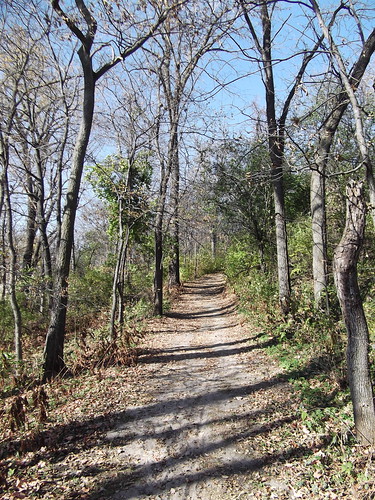
Sometimes spring skiing is great: warm temperatures, sunshine, interesting and fun snow. Today was not that day here in Northfield, but goddamn if I didn’t have One Last Ski™ – a solid and sweaty hour in conditions that included foot-deep slush, inch-thick ice, and various obstacles. I prefer to think of these obstacles as increasing the technical difficulty of the course. And thank god for “rock skis”!
Bare Ground
Ten feet further, I had to ski over a foot-wide isthmus of ice between two open expanses of ski-eating gravel.
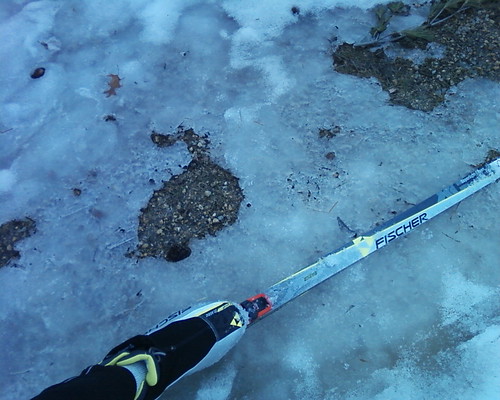
Deer Crap
Perhaps the fiftieth collection of deer crap on the trail.

Standing Water
You can’t really see it, but there are numerous inch-deep puddles of water here on this “snow.”
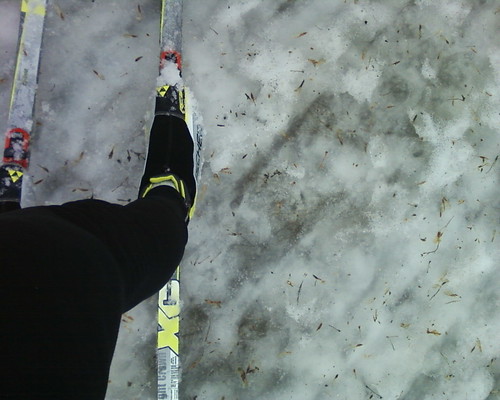
I guess winter is well and truly over. Yeah, we might get one last storm, but even a colossal one won’t save the skiing, which is now finished until December – November if I’m really lucky.
This isn’t all bad. The snow looks horrible right now – brown, filthy, icy junk – so it definitely needs to go. We could use a few solid rainfalls to wash the grit off the pavement, cleaning it up for rollerskiing. I think my skiing improved quite a bit this winter, which encourages me to try to use RS’ing and other “ski specific” workouts to maintain some of my form and strength. I don’t want to start from scratch next winter.
Though this week has been gray and damp, I hope we get a string of warm, sunny days to dry off the Arb trails and the gravel roads. I haven’t run since November, but I can’t wait to get back into the Arb for some nice muddy runs. And a few long bike rides on the endless gravel roads would be an even better way to welcome spring.
The 86th Vasaloppet, described as the largest (15,000 skiers), longest (90km), and oldest (1921) ski race in the world, was run in Sweden on Sunday morning. The race is an amazing spectacle and a magnificent athletic event. The Swedes pay attention to it the same way Americans pay attention to the Super Bowl, with the key difference that tens of thousands of Swedes (and others from all over the world) actually get to race in the Vasaloppet itself or in the daily races that lead up to the big event over the previous week.
Being a fan of nordic skiing, I got up very early to watch the webcast of the race on Swedish TV. I wasn’t disappointed, as my liveblog on my other blog shows: Both the men’s and the women’s races were great, with plenty of suspense, great tactics, and excellent finishes, but the men’s race was the culmination of a story of athletic redemption that I find kind of inspiring.
On the men’s side, this year’s race was fairly typical. A big pack of racers traveled together over the first third or so of the race – that is, 30km or about 19 miles. Over the second third, that pack was slowly winnowed down as the weaker racers dropped away and those who were feeling strong pushed the pace. In the last third of the race (the chunk that I liveblogged), the shrinking lead group was finally cracked under the relentless and rather incredible power of the Swedish skier Daniel Tynell, who surged again and again. Only three skiers could follow Tynell, who has won the Vasaloppet three times: the Norwegian racer Jørgen Aukland (who won the race in 2008); Stanislav Rezac, a Czech racer; and Jörgen Brink, a Swedish skier who was numbered among the best in the world about ten years ago, but had only recently turned to the ultra-long distance ski marathons. Over the last 10k, Tynell tried again and again to escape from Aukland, Rezac, and Brink, but he simply couldn’t do it, and finally decided to sit in, conserve his strength, and then win the sprint to the finish line in Mora.
He tried to hardest to execute that plan, but he didn’t count on Brink, who had done very little work over the previous 30 or so kilometers. As the foursome rushed toward the line, cheered on by thousands of spectators, Brink jumped out from behind Tynell and put in a big push. Tynell counterattacked, but Brink went even harder and eked out the victory by the length of a ski boot – less than a second, after racing for 4 hours, 2 minutes, and 59 seconds. (You can see the sprint at about the 50-second mark of this video.)
Winning the most prestigious race outside of the Olympics and World Championships is a momentous act of redemption for Brink, for until now he has been best known – not to say notorious – for one of the worst and strangest events in cross-country skiing, a bizarre mental and physical collapse in the men’s relay at the 2003 World Championships in Val di Fiemme, Italy. He cost Sweden a gold medal in the race, the marquee event at any World Championships or Olympics, and the event more than any other which establishes a country at the best ski country in the world.
Wearing bib number 13, Brink started the last leg of the relay with a sizable 10-second lead over Russia and more than 20 seconds over Norway and Germany. But Norway’s anchor leg skier was the formidable Thomas Alsgaard, who was notorious for his power and speed at the end of races, especially relay races. Going into the 2003 Worlds, Alsgaard had delivered two gold medals at the two previous Olympics, and everyone at Val di Fiemme knew that he would try very hard to close the gap to Brink and win the gold for Norway.
Nobody knew this more than Brink, of course. He skied strongly until about 8km into his 10km leg, at which point – he said afterwards – he was simply overwhelmed by the stress of knowing he was being hunted down by Alsgaard. On the last big climb of the race, with basically just one long downhill to the stadium and the win, Brink slowed nearly to a stop, blacked out, and lost the race. The event happens about a minute into this video. Listen to the disbelief and excitement in the Norwegian announcers’ voices: they’ve literally never seen anything like this before.
To his credit, Brink rallied after Alsgaard and Teichmann sailed past him, saving at least the bronze for Sweden, but it was a monumental “kollaps,” and it basically ruined Brink. The phrase “do a Brink” even became a cruel bit of slang in Norway. After winning another bronze in an individual race the next week, his skiing fortunes declined rapidly and precipitously. He performed poorly enough that he lost his spot on the Swedish national team by 2005, at an age when he should have been nearing the peak of his powers. Though he tried the Vasaloppet in 2007 and finished third, he nonetheless abandoned cross-country skiing in favor of the skiing-and-shooting sport of biathlon, avowedly aiming to make Sweden’s 2010 Olympic team. Hardly a marksman, he found little success, and wasn’t chosen for Vancouver.
I think most people would have hung up their skis at this point, but Brink didn’t. Seeing that Sweden’s national cross-country ski team was now full of talent, he chose instead to try his hand at the ultra-long distance events of the “Marathon Cup,” a circuit which includes the Vasaloppet. And here he has found success, taking a hard-fought second place in a big marathon in Estonia and now winning the Vasaloppet in exciting and historic fashion.
In five (or six) units…
1. Articles I Read:
A. Popular
“God Said Multiply, and Did She Ever” (Joseph Berger, New York Times, February 18, 2010)
When Yitta Schwartz died last month at 93, she left behind 15 children, more than 200 grandchildren and so many great- and great-great-grandchildren that, by her family’s count, she could claim perhaps 2,000 living descendants. Mrs. Schwartz was a member of the Satmar Hasidic sect, whose couples have nine children on average and whose ranks of descendants can multiply exponentially. But even among Satmars, the size of Mrs. Schwartz’s family is astonishing. A round-faced woman with a high-voltage smile, she may have generated one of the largest clans of any survivor of the Holocaust — a thumb in the eye of the Nazis.
B. Geek
“Ski Switching and Waxing in the 30km Classic” (Topher Sabot, Fasterskier.com, February 28th, 2010)
A great, if technical examination of an interesting new twist to cross-country ski racing: allowing athletes to change skis in the middle of certain long races so as to find a faster or otherwise better pair. Ski switching builds in new tactical element, since athletes have to carefully choose when to take the 10 to 20 seconds needed to change, as well as an element of luck, since they (and their technicians) might choose the wrong skis, and thus ruin a good race.
2. Book I Started
At a friend’s recommendation, I started Hilary Mantel’s Wolf Hall, a novel about Thomas Cromwell, a power behind the throne of Henry VIII. I’m going to dole this book out to myself in very, very small doses, because – as signified by winning the Man Booker prize last year – this is a fantastic work of art. The writing is superb, but even more impressive than the prose style is the intellectual power deployed by Mantel in making someone like Cromwell both comprehensible and admirable. (Here’s a laudatory review of the book, which mentions a sequel.)
3. Photo I Saw
Shot by Al Bello and seen in the “Big Picture” photo series of the Boston Globe. (The first and second “Big Pictures” from the Olympic Games are both incredible.)
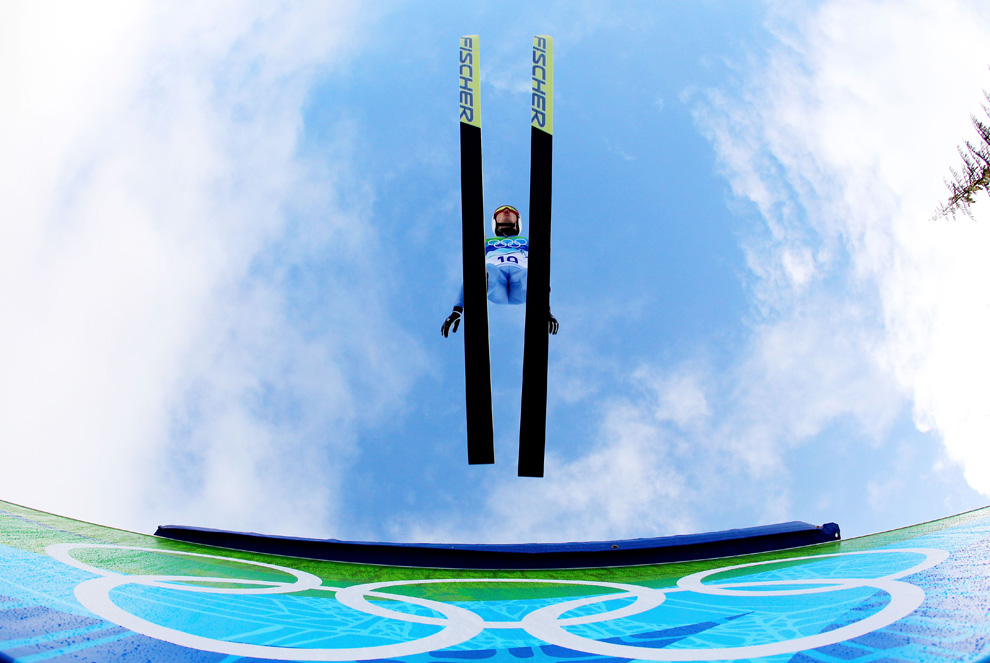
4. Video I Watched:
“Demong sprints away” | NBC Olympics – the “raw feed” of Billy Demong attacking from the front of the last nordic combined race, dropping Bernhard Gruber of Austria and Johnny Spillane (USA), and surging to America’s first-ever Olympic gold medal in a nordic discipline.
5. Music I Enjoyed
“You’ll Never Walk Alone” by Shirley Bassey (composed by Rodgers and Hammerstein). Ignore the goofball sentimentalism of the commercial and enjoy the goofball sentimentalism of the song.
The nordic events at the Vancouver Winter Olympic Games were colossally exciting to watch. The best single moment for me was Billy Demong’s gold-winning attack in the last nordic combined race, last Thursday. Demong’s medal – part of huge American haul in nordic combined which also included two silvers from Johnny Spillane and a silver in the team competition – was just one great moment, though. Many of the biathlon events and virtually all of the cross-county events were exciting, down-to-the-wire affairs.
The last cross-country race, the men’s 50-kilometer, lived up to its precursors at the Games, with a mad final sprint culminating two hours of hard racing. Petter Northug, the world’s best male XC skier right now, took the gold by finishing three-tenths of a second ahead of Axel Teichmann, a German who is himself a phenomenal racer but who also has a knack for losing to Northug. The bronze went to Johan Olsson, a hardworking Swede whose efforts animated three of the XC races at Vancouver and who crossed the finish line another seven-tenths after Teichmann. A half second behind Olsson came Tobias Angerer, another German and now the possessor of the dubious “wooden medal” that goes to fourth-placed finishers.
Then – just a tenth of a second later – came one of my favorite racers, the Canadian Devon Kershaw. His fifth place matched the best-ever finish by a male Canadian XC skier (a record set last Saturday), but it also capped a herculean effort in the race from Kershaw, who had raced well but not up to his standard at the Games. A prolific blogger and Twitter-user, Kershaw seems to be a great guy – someone who works hard, who doesn’t take himself too seriously, and who has overcome no small amount of tragedy in his life to become one of the world’s best cross-country racers. If he’d somehow just been a half-meter further up the straightaway, he’d be wearing a medal right now. But the near misses are as much a part of the Olympics as the medals. I hope he gets another chance in four years. I doubt he’ll miss it then.

I know that for really fit and fast skiers, the men and women who win citizens’ races and better, 50 kilometers is a serious but not frighteningly tough distance to ski, either as training or in a race.
On the other hand, this middle-of-the-pack racer found 50 kilometers to be an awfully long way to ski – and simultaneously a fun way to spend the better part of an afternoon. Conditions were fantastic, for starters: the weather was ideal – beautifully sunny, pretty much windless, just about 20°F – and the trails were in very good shape – good classic tracks everywhere (solid and glazing over the course of the afternoon).
More than all that, I had juuust enough fitness to do the full 50 kilometers. I decided to try to double pole the whole thing, and happily the first 30km were pretty easy. I was consciously keeping my speed down and letting the slippery tracks do a lot of the work. The next 10km were substantially tougher, since my core muscles were weakening rapidly. Eating and drinking regularly helped slow down the onset of real fatigue.
The last 10km – even though I downed about 20oz of flat Coke and a caffeinated gel – were positively brutal. Every double pole made my shoulders feel like they were being squeezed in a vise. I climbed the last hill – a steep 200m ramp near the start of the last lap – at the slowest possible speed, just one missed pole-plant away from actually going backwards. But knowing the trails (and seeing the data on my watch) helped me break that last lap up into manageable segments, which steadily ticked by. I was pretty happy to hit 50km, at 3:33 into the ski – and even happier to glide into the “finish” a little bit later.*
In sum, though, my little Oakebeiner experiment was a great way to enjoy a beautiful winter’s day, and – I hope – valuable preparation for an actual marathon ski race. We’re only 352 days away from the 42km Mora Vasaloppet marathon in northern Minnesota!
Right now, though, I’m sitting on the sofa, soaking up the really incredible soreness of pretty much every muscle group above the waist (even my jaw is sore – wha?) and wondering just how I’ll feel tomorrow. I’d better keep the bottle of ibuprofen handy.
the final tallies
time: 3:34:47
distance: 50.21 km (31.1 miles)
pace: 4:17/kilometer (thanks to marginally better fitness and much faster tracks, this is actually almost exactly the same pace at which I skied the 24km City of Lakes Loppet earlier in the month!)
average heart rate: 145 beats per minute
nominal calories burned: 3,703 kcal
In today’s nordic combined event at the Olympics, Americans Bill Demong and Johnny Spillane raced extremely well, working together to take over the race and then, with just one Austrian skier in tow, to launch a vicious attack that brought them to the finish line for a gold and silver. A GOLD AND A SILVER! IN A NORDIC SKI RACE! Amazing.
For nordic skiers in the US and other snowy regions of the world, late winter means ski marathons – long races that focus the fitness built up all fall and winter into some tough competition. The biggest ski marathon of them all, the 90 kilometer (56 mile) Vasaloppet, takes place in a couple weeks in Sweden; the biggest ski marathon in North America, the famed Birkebeiner (50km/31 miles in the freestyle technique or 54km/33.5 miles in the classic), will be run this Sunday in northern Wisconsin.
Though I want to ski both of those races (and others) someday, this ain’t the year.
Instead, I’m going to take advantage of our great snow and good weather and my underused stash of vacation days to ski my own classic-technique “marathon” in Carleton’s Lower Arboretum on Friday. I can get to the magical 50km mark by doing seven laps of my favorite 7.5km loop, which hits a few easy hills and covers lots of flat terrain in three of the Arb’s main ecosystems: tallgrass prairie, upland forest, and oak savanna.
This “Oakebeiner” won’t be a race, much less the Birkie or the Vasaloppet, but by golly it’ll be good enough for this winter – not least because I’ll ski past this beautiful tree fourteen times:
(If any Northfielders want to join me, they will be able to find me in the Lower Arb from about 11 a.m. until 3 p.m. on Friday. I’ll be using the trailhead at the West Gym parking lot as the start/end of each lap.)